Do you have a question about the Kobelco SK235SR-2 and is the answer not in the manual?
General information on operation and maintenance.
Periodic service inspections after delivery.
Product improvements may be made without notice.
Instructions on manual storage for quick reference.
Information for ordering parts and service.
California emission control warranty statement.
General safety info, alert symbols, signal words, and precautions.
Basic safety precautions for maintenance and operation.
Explanation of warning labels and decals and their maintenance.
Safety measures before starting engine or operation.
Safety guidelines to follow during machine operation.
Safety procedures for inspection and maintenance tasks.
Safety precautions for handling batteries and preventing explosions.
Prohibited machine operations that can cause damage or injury.
Procedures to follow at the end of each work shift for safety.
Safety precautions and procedures for towing the machine.
Importance of visibility and how to ensure it for safe operation.
Identifies and lists the main components of the hydraulic excavator.
Points out locations of operator controls and components within the cab.
Provides brief descriptions of components and controls.
Explains the gauge cluster, meters, switches, and multi-display.
Illustrates and lists the location of various switches and meters.
Describes safety lock lever, control levers, and travel levers/pedals.
Information on the fuse and relay box, including replacement.
Details about the fusible link for the starter system and its inspection.
Locates the Mechatro-controller and Engine Controller.
How to operate the radio unit.
Describes the air conditioner system and usage precautions.
Instructions on how to fasten and unfasten the seat belt.
Details operator seat adjustment mechanisms for comfort and safety.
Instructions on how to adjust armrest height.
Describes how to adjust control stand height.
Information on cab door lock and releasing it from inside.
Procedures for emergency escape from the cab.
Details on optional equipment like tool box and cup holder.
General section on machine operation.
Daily inspection checklist before starting the engine.
Pre-start checks for coolant and engine oil levels.
Adjusting the operator's seat for comfort and control access.
Instructions on adjusting mirrors for optimal visibility.
Checking the gauge cluster and warning displays before starting.
Procedure to check the function of work lights.
Step-by-step guide for starting the engine, including cold conditions.
Correct procedure for stopping the machine engine.
Checks to perform after the engine has started.
Procedures for warming up the engine and hydraulic oil.
How to select work modes and switch attachment modes.
Explanation of the controls decal and operating patterns.
General instructions and cautions for operating the machine.
Important cautions to observe during general machine operation.
Procedures for traveling the machine, including speed changes.
Detailed steps for forward and reverse travel operations.
How to perform pivot turns using travel levers.
Instructions for performing counter-rotating or spin turns.
How to change between low and high travel speeds.
Correct method for stopping the machine's travel.
Precautions for operating the machine in water or mud.
Procedures for freeing the machine if stuck in soft ground or mud.
Operation of boom, arm, and bucket controls.
How to operate the boom using the control lever.
How to operate the arm using the control lever.
How to operate the bucket using the control lever.
Procedures for performing swing operations safely.
How to use the power boost function for increased digging power.
Tips and techniques to improve digging efficiency.
Using the arm effectively for shallow digging.
Importance of smooth boom operation to avoid stress.
Proper orientation of bucket teeth for efficient digging.
Optimal boom and arm angles for maximum digging force.
Method for cleaning sand and soil from the bucket.
When to release the swing lever to stop swing action.
Procedures for backfilling and leveling operations.
How to perform digging operations with a shovel attachment.
Compilation of hand signals for excavator operation with a flagman.
Hand signal for raising a load vertically.
Hand signal for lowering a load vertically.
Hand signal for moving a load horizontally.
Hand signal for moving a load horizontally away from the operator.
Hand signal for raising the boom.
Hand signal for lowering the boom.
Hand signal for swinging the machine to the left.
Hand signal for swinging the machine to the right.
Hand signal for retracting the arm.
Hand signal for extending the arm.
Hand signal for counter-rotating the machine to the left.
Hand signal for counter-rotating the machine to the right.
Hand signal for traveling the machine forward.
Hand signal for traveling the machine in reverse.
Hand signal for closing the bucket or digging.
Hand signal for opening the bucket or dumping.
Hand signal for turning the machine left.
Hand signal for turning the machine right.
Hand signal indicating how far to move.
Hand signal for moving slowly.
Hand signal for stopping.
Hand signal for an emergency stop.
Hand signal for stopping the engine.
Procedures for safely parking the machine.
Safety checks and procedures after operating the machine.
Guidelines for operating in extreme cold or heat.
Specific precautions for operating in very cold temperatures.
Precautions for operating in hot climates.
Considerations for operating at high altitudes.
Maintenance tips for sandy and dusty environments.
Precautions for operating in coastal or salty environments.
Recommendations for operating in high humidity climates.
General info and recommendations for maintenance schedules.
General safety and precautions during maintenance.
Specifications for oils, grease, fuels, and coolant for climates.
Precautions and procedures for using biodegradable hydraulic oil.
Lists essential filters, elements, and bucket parts with intervals.
Table of torque values for specified bolts and nuts.
General guidelines and tables for proper bolt and nut torques.
Torque specs for various joints and hydraulic hoses.
Comprehensive chart detailing inspection and maintenance intervals.
Procedures for maintenance tasks performed only when necessary.
Steps for cleaning or replacing the radiator cap.
How to check and replace wiper blades.
Procedure for checking and refilling washer fluid.
Safety precautions and steps for replacing the bucket.
Step-by-step guide for removing the bucket.
Step-by-step guide for installing the bucket.
Inspecting bucket tooth points and side cutters for wear.
How to replace bucket tooth points when worn.
Procedure for replacing the side cutters.
Procedures for reversing the backhoe bucket for shoveling.
How to adjust bucket mounting gap for proper clearance.
Inspection and maintenance tasks every 8 hours.
Lubrication intervals for various attachments.
Inspection and maintenance tasks every 50 hours or weekly.
Safety precautions and procedures for battery inspection and maintenance.
How to check and maintain battery liquid level.
Procedure for measuring battery liquid specific gravity.
Procedure for draining water and sediment from the fuel tank.
How to check and adjust track tension.
Inspection and maintenance tasks every 120 hours.
Checking and topping up swing motor reduction unit oil.
Checking and topping up travel reduction unit oil.
Inspection of intake rubber hoses for damage and deterioration.
Inspection and maintenance tasks every 250 hours or 3 months.
Checking wear and tension of fan, alternator, and A/C belts.
How to adjust alternator and fan belt tension.
How to adjust A/C compressor belt tension.
Inspecting radiator hoses for leaks and damage.
Visual check of radiator hoses for leaks.
Procedure for replacing radiator hoses.
Service procedures for air conditioner filters.
How to remove the fresh air filter.
How to remove the recirculation air filter.
How to clean the air filters.
Procedure for attaching cleaned or new air filters.
Maintenance procedures for the air cleaner.
How to clean or replace the outer air cleaner element.
How to replace the inner air cleaner element.
Cleaning the radiator and oil cooler debris screens.
Inspection and maintenance tasks every 500 hours.
Procedures for replacing engine oil and oil filter.
How to replace the fuel filter.
Procedure for replacing the fuel pre-filter.
Steps to bleed air from the fuel system.
How to clean the fuel tank cap and strainer.
Inspection and maintenance tasks every 1000 hours or 12 months.
Procedure for replacing hydraulic return filters.
How to replace the air breather element.
Checking engine mounting bracket bolts for tightness.
How to measure and check battery voltage.
Inspection and maintenance tasks every 2000 hours.
Procedure for changing the engine coolant.
Inspection and maintenance tasks every 5000 hours.
Procedure for changing the hydraulic oil.
Procedures for storing the machine for extended periods.
Steps for preparing the machine for storage.
Recommended care procedures for a stored machine.
Procedures before taking the machine out of storage.
Procedures for preparing the machine for ground transport.
Key steps and considerations for preparing the machine for transport.
Safety precautions and procedures for loading and unloading the machine.
Specific guidance for using ramps during loading/unloading.
Steps for securely fixing the machine after loading for transport.
Procedures for safely unloading the machine.
Procedures and safety precautions for lifting the machine.
How to install and remove mirrors for safety and visibility.
General specifications for SK235SR-2 and SK235SRLC-2.
Details on different shoe types and their specifications.
Working range diagrams and specs for backhoe and shovel attachments.
Info on compatible bucket and arm combinations.
Operation of hydraulic breaker and nibbler attachments.
Guidance on selecting the optimal breaker or nibbler.
Important considerations before operating breakers or nibblers.
Precautions against impurity and hydraulic oil contamination.
How to select the correct attachment mode.
Procedure for setting the stop valve for hydraulic oil flow.
How to change the flow rate of the service circuit.
Basic operation guidelines for breaker and nibbler attachments.
How to use the selector switch for breaker/nibbler modes.
How to operate the foot pedal for attachment control.
How to use the pedal lock device for safety.
Prohibited work practices when using a breaker attachment.
Recommended inspection and maintenance intervals for hydraulic oil and filters.
When arm reinforcement is required for specific applications.
Prohibited work practices when using a nibbler attachment.
Precautions when handling breakers from different manufacturers.
How to change and operate the rotary multi-control valve patterns.
Procedure for parking and changing the control pattern lever.
How to operate the dozer blade attachment.
Basic description of the dozer blade attachment.
Step-by-step guide for operating the dozer blade.
Prohibited work practices when using the dozer blade.
Inspection and maintenance intervals for the dozer blade.
Dimensional specifications for the dozer blade.
How to operate the cab working light switch.
General info on spring brake systems and special procedures.
Detailed procedures and tools for releasing travel motor brakes.
List of necessary tools and equipment for brake release.
Step-by-step instructions for releasing travel motor brakes.
Procedures and recommendations for releasing swing brake manually.
List of tools and equipment for swing brake release.
Step-by-step instructions for releasing the swing brake.
Procedures for lowering attachment during engine failure.
Method to lower attachment using port relief valve.
Method to lower attachment using holding valve relief.
How to release air pressure from the hydraulic tank.
General information on operation and maintenance.
Periodic service inspections after delivery.
Product improvements may be made without notice.
Instructions on manual storage for quick reference.
Information for ordering parts and service.
California emission control warranty statement.
General safety info, alert symbols, signal words, and precautions.
Basic safety precautions for maintenance and operation.
Explanation of warning labels and decals and their maintenance.
Safety measures before starting engine or operation.
Safety guidelines to follow during machine operation.
Safety procedures for inspection and maintenance tasks.
Safety precautions for handling batteries and preventing explosions.
Prohibited machine operations that can cause damage or injury.
Procedures to follow at the end of each work shift for safety.
Safety precautions and procedures for towing the machine.
Importance of visibility and how to ensure it for safe operation.
Identifies and lists the main components of the hydraulic excavator.
Points out locations of operator controls and components within the cab.
Provides brief descriptions of components and controls.
Explains the gauge cluster, meters, switches, and multi-display.
Illustrates and lists the location of various switches and meters.
Describes safety lock lever, control levers, and travel levers/pedals.
Information on the fuse and relay box, including replacement.
Details about the fusible link for the starter system and its inspection.
Locates the Mechatro-controller and Engine Controller.
How to operate the radio unit.
Describes the air conditioner system and usage precautions.
Instructions on how to fasten and unfasten the seat belt.
Details operator seat adjustment mechanisms for comfort and safety.
Instructions on how to adjust armrest height.
Describes how to adjust control stand height.
Information on cab door lock and releasing it from inside.
Procedures for emergency escape from the cab.
Details on optional equipment like tool box and cup holder.
General section on machine operation.
Daily inspection checklist before starting the engine.
Pre-start checks for coolant and engine oil levels.
Adjusting the operator's seat for comfort and control access.
Instructions on adjusting mirrors for optimal visibility.
Checking the gauge cluster and warning displays before starting.
Procedure to check the function of work lights.
Step-by-step guide for starting the engine, including cold conditions.
Correct procedure for stopping the machine engine.
Checks to perform after the engine has started.
Procedures for warming up the engine and hydraulic oil.
How to select work modes and switch attachment modes.
Explanation of the controls decal and operating patterns.
General instructions and cautions for operating the machine.
Important cautions to observe during general machine operation.
Procedures for traveling the machine, including speed changes.
Detailed steps for forward and reverse travel operations.
How to perform pivot turns using travel levers.
Instructions for performing counter-rotating or spin turns.
How to change between low and high travel speeds.
Correct method for stopping the machine's travel.
Precautions for operating the machine in water or mud.
Procedures for freeing the machine if stuck in soft ground or mud.
Operation of boom, arm, and bucket controls.
How to operate the boom using the control lever.
How to operate the arm using the control lever.
How to operate the bucket using the control lever.
Procedures for performing swing operations safely.
How to use the power boost function for increased digging power.
Tips and techniques to improve digging efficiency.
Using the arm effectively for shallow digging.
Importance of smooth boom operation to avoid stress.
Proper orientation of bucket teeth for efficient digging.
Optimal boom and arm angles for maximum digging force.
Method for cleaning sand and soil from the bucket.
When to release the swing lever to stop swing action.
Procedures for backfilling and leveling operations.
How to perform digging operations with a shovel attachment.
Compilation of hand signals for excavator operation with a flagman.
Hand signal for raising a load vertically.
Hand signal for lowering a load vertically.
Hand signal for moving a load horizontally.
Hand signal for moving a load horizontally away from the operator.
Hand signal for raising the boom.
Hand signal for lowering the boom.
Hand signal for swinging the machine to the left.
Hand signal for swinging the machine to the right.
Hand signal for retracting the arm.
Hand signal for extending the arm.
Hand signal for counter-rotating the machine to the left.
Hand signal for counter-rotating the machine to the right.
Hand signal for traveling the machine forward.
Hand signal for traveling the machine in reverse.
Hand signal for closing the bucket or digging.
Hand signal for opening the bucket or dumping.
Hand signal for turning the machine left.
Hand signal for turning the machine right.
Hand signal indicating how far to move.
Hand signal for moving slowly.
Hand signal for stopping.
Hand signal for an emergency stop.
Hand signal for stopping the engine.
Procedures for safely parking the machine.
Safety checks and procedures after operating the machine.
Guidelines for operating in extreme cold or heat.
Specific precautions for operating in very cold temperatures.
Precautions for operating in hot climates.
Considerations for operating at high altitudes.
Maintenance tips for sandy and dusty environments.
Precautions for operating in coastal or salty environments.
Recommendations for operating in high humidity climates.
General info and recommendations for maintenance schedules.
General safety and precautions during maintenance.
Specifications for oils, grease, fuels, and coolant for climates.
Precautions and procedures for using biodegradable hydraulic oil.
Lists essential filters, elements, and bucket parts with intervals.
Table of torque values for specified bolts and nuts.
General guidelines and tables for proper bolt and nut torques.
Torque specs for various joints and hydraulic hoses.
Comprehensive chart detailing inspection and maintenance intervals.
Procedures for maintenance tasks performed only when necessary.
Steps for cleaning or replacing the radiator cap.
How to check and replace wiper blades.
Procedure for checking and refilling washer fluid.
Safety precautions and steps for replacing the bucket.
Step-by-step guide for removing the bucket.
Step-by-step guide for installing the bucket.
Inspecting bucket tooth points and side cutters for wear.
How to replace bucket tooth points when worn.
Procedure for replacing the side cutters.
Procedures for reversing the backhoe bucket for shoveling.
How to adjust bucket mounting gap for proper clearance.
Inspection and maintenance tasks every 8 hours.
Lubrication intervals for various attachments.
Inspection and maintenance tasks every 50 hours or weekly.
Safety precautions and procedures for battery inspection and maintenance.
How to check and maintain battery liquid level.
Procedure for measuring battery liquid specific gravity.
Procedure for draining water and sediment from the fuel tank.
How to check and adjust track tension.
Inspection and maintenance tasks every 120 hours.
Checking and topping up swing motor reduction unit oil.
Checking and topping up travel reduction unit oil.
Inspection of intake rubber hoses for damage and deterioration.
Inspection and maintenance tasks every 250 hours or 3 months.
Checking wear and tension of fan, alternator, and A/C belts.
How to adjust alternator and fan belt tension.
How to adjust A/C compressor belt tension.
Inspecting radiator hoses for leaks and damage.
Visual check of radiator hoses for leaks.
Procedure for replacing radiator hoses.
Service procedures for air conditioner filters.
How to remove the fresh air filter.
How to remove the recirculation air filter.
How to clean the air filters.
Procedure for attaching cleaned or new air filters.
Maintenance procedures for the air cleaner.
How to clean or replace the outer air cleaner element.
How to replace the inner air cleaner element.
Cleaning the radiator and oil cooler debris screens.
Inspection and maintenance tasks every 500 hours.
Procedures for replacing engine oil and oil filter.
How to replace the fuel filter.
Procedure for replacing the fuel pre-filter.
Steps to bleed air from the fuel system.
How to clean the fuel tank cap and strainer.
Inspection and maintenance tasks every 1000 hours or 12 months.
Procedure for replacing hydraulic return filters.
How to replace the air breather element.
Checking engine mounting bracket bolts for tightness.
How to measure and check battery voltage.
Inspection and maintenance tasks every 2000 hours.
Procedure for changing the engine coolant.
Inspection and maintenance tasks every 5000 hours.
Procedure for changing the hydraulic oil.
Procedures for storing the machine for extended periods.
Steps for preparing the machine for storage.
Recommended care procedures for a stored machine.
Procedures before taking the machine out of storage.
Procedures for preparing the machine for ground transport.
Key steps and considerations for preparing the machine for transport.
Safety precautions and procedures for loading and unloading the machine.
Specific guidance for using ramps during loading/unloading.
Steps for securely fixing the machine after loading for transport.
Procedures for safely unloading the machine.
Procedures and safety precautions for lifting the machine.
How to install and remove mirrors for safety and visibility.
General specifications for SK235SR-2 and SK235SRLC-2.
Details on different shoe types and their specifications.
Working range diagrams and specs for backhoe and shovel attachments.
Info on compatible bucket and arm combinations.
Operation of hydraulic breaker and nibbler attachments.
Guidance on selecting the optimal breaker or nibbler.
Important considerations before operating breakers or nibblers.
Precautions against impurity and hydraulic oil contamination.
How to select the correct attachment mode.
Procedure for setting the stop valve for hydraulic oil flow.
How to change the flow rate of the service circuit.
Basic operation guidelines for breaker and nibbler attachments.
How to use the selector switch for breaker/nibbler modes.
How to operate the foot pedal for attachment control.
How to use the pedal lock device for safety.
Prohibited work practices when using a breaker attachment.
Recommended inspection and maintenance intervals for hydraulic oil and filters.
When arm reinforcement is required for specific applications.
Prohibited work practices when using a nibbler attachment.
Precautions when handling breakers from different manufacturers.
How to change and operate the rotary multi-control valve patterns.
Procedure for parking and changing the control pattern lever.
How to operate the dozer blade attachment.
Basic description of the dozer blade attachment.
Step-by-step guide for operating the dozer blade.
Prohibited work practices when using the dozer blade.
Inspection and maintenance intervals for the dozer blade.
Dimensional specifications for the dozer blade.
How to operate the cab working light switch.
General info on spring brake systems and special procedures.
Detailed procedures and tools for releasing travel motor brakes.
List of necessary tools and equipment for brake release.
Step-by-step instructions for releasing travel motor brakes.
Procedures and recommendations for releasing swing brake manually.
List of tools and equipment for swing brake release.
Step-by-step instructions for releasing the swing brake.
Procedures for lowering attachment during engine failure.
Method to lower attachment using port relief valve.
Method to lower attachment using holding valve relief.
How to release air pressure from the hydraulic tank.
| Brand | Kobelco |
|---|---|
| Model | SK235SR-2 |
| Category | Excavators |
| Language | English |
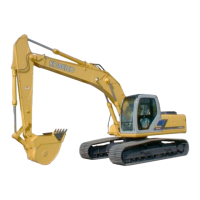




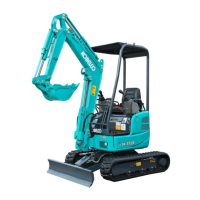

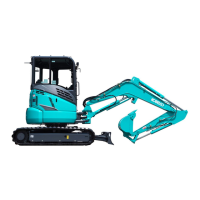

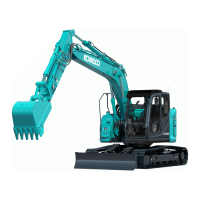
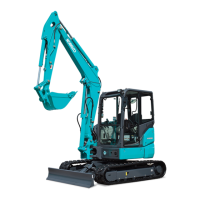

